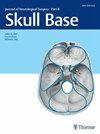局部晚期鼻窦鳞状细胞癌的诱导化疗
IF 0.9
4区 医学
Q3 Medicine
引用次数: 0
摘要
背景:越来越多的证据表明,诱导化疗(IC)在局部晚期鼻窦鳞状细胞癌(SNSCC)的最终治疗中发挥作用。我们评估了诱导化疗对SNSCC患者生存期的影响以及使用诱导化疗的预测因素:我们查询了 2004-2017 年全国癌症数据库中的局部晚期 SNSCC(T4/M0)患者。治疗方法分为7组:确定性化疗(CRT)、IC加确定性CRT(IC+CRT)、IC+CRT加挽救手术(IC+CRT+Sx)、确定性手术(Sx)、IC加确定性手术(IC+Sx)、确定性手术加辅助放疗或CRT(Sx+ATx)或IC+Sx+ATx。Cox比例危险回归评估了总生存率(OS),逻辑回归确定了IC的预测因素:3162名患者中,1088名(34.4%)为女性,平均年龄为(63.4±13.4)岁。2年和5年的OS率分别为58.6%和42.0%。与CRT相比,Sx+ATx(HR:0.663;p<0.001)、IC+Sx(HR:0.606;p=0.005)或IC+Sx+ATx(HR:0.468;p=0.001)的死亡率均有所降低。在接受明确手术治疗的患者中,接受IC治疗的患者在OS方面有额外的获益(均P<0.05)。高龄(OR:0.607;p<0.001)、女性(OR:0.759;p=0.028)、黑人(OR:1.650;p<0.001)、T4b分期(OR:1.674;p<0.001)和较高的N分期(OR:1.395;p<0.001)是IC的预测因素:结论:对于局部晚期SNSCC而言,在接受或不接受辅助治疗的明确手术前进行IC显示出最高的OS。年龄、性别、种族和T/N分期是IC的预测因素。因此,以手术为主要方式的多模式治疗方案可能会带来最大的治疗效果。本文章由计算机程序翻译,如有差异,请以英文原文为准。
Induction Chemotherapy for Locoregionally Advanced Sinonasal Squamous Cell Carcinoma
Background: There is emerging evidence to suggest the role of induction chemotherapy (IC) in definitive management of locoregionally advanced sinonasal squamous cell carcinoma (SNSCC). We evaluated the influence of IC on survival and predictors of its use in SNSCC patients.
Methods: The 2004-2017 National Cancer Database was queried for patients with locoregionally advanced SNSCC (T4/M0). Treatments were stratified into 7 groups: definitive chemoradiation (CRT), IC with definitive CRT (IC+CRT), IC+CRT with salvage surgery (IC+CRT+Sx), definitive surgery (Sx), IC with definitive surgery (IC+Sx), definitive surgery with adjuvant radiation or CRT (Sx+ATx), or IC+Sx+ATx. Cox proportional-hazards regression assessed overall survival (OS) and logistic regression identified predictors of IC.
Results: Of 3162 patients, 1088 (34.4%) were female with a mean age of 63.4 ± 13.4 years. The 2- and 5-year OS rates were 58.6% and 42.0%, respectively. Compared to CRT, Sx+ATx (HR: 0.663; p<0.001), IC+Sx (HR: 0.606; p=0.005), or IC+Sx+ATx (HR: 0.468; p=0.001) exhibited reduced mortality. Among patients who were treated with definitive surgery, those receiving IC had additional OS benefit (all p<0.05). Older age (OR: 0.607; p<0.001), female sex (OR: 0.759; p=0.028), black race (OR: 1.650; p<0.001, T4b stage (OR: 1.674; p<0.001), and higher N stage (OR: 1.395; p<0.001) were predictors of IC.
Conclusions: IC prior to definitive surgery with or without adjuvant therapy exhibited the highest OS for locoregionally advanced SNSCC. Age, sex, race, and T/N staging were predictors of IC. Multimodal treatment regimens involving surgery as the primary modality may, therefore, provide the greatest therapeutic response.
求助全文
通过发布文献求助,成功后即可免费获取论文全文。
去求助
来源期刊

Journal of Neurological Surgery Part B: Skull Base
CLINICAL NEUROLOGY-SURGERY
CiteScore
2.20
自引率
0.00%
发文量
516
期刊介绍:
The Journal of Neurological Surgery Part B: Skull Base (JNLS B) is a major publication from the world''s leading publisher in neurosurgery. JNLS B currently serves as the official organ of several national and international neurosurgery and skull base societies.
JNLS B is a peer-reviewed journal publishing original research, review articles, and technical notes covering all aspects of neurological surgery. The focus of JNLS B includes microsurgery as well as the latest minimally invasive techniques, such as stereotactic-guided surgery, endoscopy, and endovascular procedures. JNLS B is devoted to the techniques and procedures of skull base surgery.
 求助内容:
求助内容: 应助结果提醒方式:
应助结果提醒方式:


